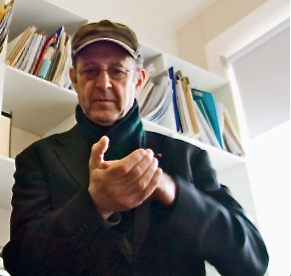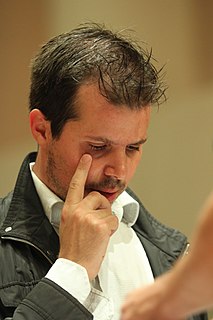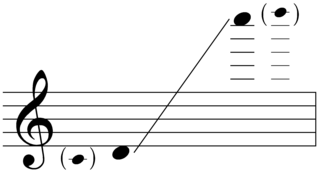
Stephen Michael Reich is an American composer who, along with La Monte Young, Terry Riley, and Philip Glass, pioneered minimal music in the mid to late 1960s.

George Henry Crumb or George Henry Jr. Crumb is an American composer of modern classical and avant-garde music. He is known as an explorer of unusual timbres, alternative forms of notation, and extended instrumental and vocal techniques, which obtained his innovative techniques in the use of vivid sonorities. Examples include seagull effect for the cello, metallic vibrato for the piano, and using a mallet to play the strings of a double bass, among numerous others.
Mark-Anthony Turnage CBE is an English composer of classical music.

Evan Ziporyn is an American composer of post-minimalist music with a cross-cultural orientation, drawing equally from classical music, avant-garde, various world music traditions, and jazz. Ziporyn has composed for a wide range of ensembles, including symphony orchestras, wind ensembles, many types of chamber groups, and solo works, sometimes involving electronics. Balinese gamelan, for which he has composed numerous works, has compositions. He is known for his solo performances on clarinet and bass clarinet; additionally, Ziporyn plays gender wayang and other Balinese instruments, saxophones, piano & keyboards, EWI, and Shona mbira.

Julia Wolfe is an American composer whose music, according to the Wall Street Journal, has "long inhabited a terrain of its own, a place where classical forms are recharged by the repetitive patterns of minimalism and the driving energy of rock." Her work Anthracite Fields, an oratorio for chorus and instruments, was awarded the 2015 Pulitzer Prize for Music. In 2015 Wolfe received the Herb Alpert Award. In September 2016 Wolfe was named a MacArthur Fellow.
James Dillon is a Scottish composer who is often regarded as belonging to the New Complexity school. Dillon studied art and design, linguistics, piano, acoustics, Indian rhythm, mathematics and computer music, but is self-taught in composition.

Michael Gordon is an American composer and co-founder of the Bang on a Can music collective and festival.

Huck Hodge is an American composer of contemporary classical music.
David Frederick Stock was an American composer and conductor.
Roger John Goeb was an American composer.
Naïve and Sentimental Music is a symphonic work by the American composer John Adams. The title of the work alludes to an essay by Friedrich Schiller, On Naïve and Sentimental Poetry, that contrasts a creative personality that creates art for its own sake versus one conscious of other purposes, such as art’s place in history. The composer cites both the slowly developing harmonies of Bruckner's Fourth Symphony and the atmosphere of the Sonoma coastline as inspirations for the work. The piece was co-commissioned by the Los Angeles Philharmonic, the Ensemble Modern, the Vancouver Symphony Orchestra, and the Sydney Symphony Orchestra. It received its first public performance by the Los Angeles Philharmonic conducted by Esa-Pekka Salonen on February 19, 1999. A recording by Salonen and the Los Angeles Philharmonic was subsequently released by Nonesuch Records.
Richard David Carrick is an American composer, pianist and conductor. He was a Guggenheim Fellow in Music Composition for 2015-16 while living in Kigali, Rwanda. His compositions are influenced by diverse sources including traditional Korean Gugak music, the flow concept of Mihaly Csikszentmihalyi, Gnawa Music of Morocco, Jazz, experimental music, concepts of infinity, the works of Italo Calvino and Ludwig Wittgenstein, and his work as improviser
Christine Southworth is an American composer of postminimal music and works with combinations of Western ensembles, electronics, and world music ensembles including Balinese gamelan and bagpipes. She performs Balinese gamelan and gender wayang with Cambridge, Massachusetts-based Gamelan Galak Tika, as well as Galician Gaita and Great Highland Bagpipes. She co-founded Ensemble Robot, a cooperative of engineers, artists and musicians working together to invent robotic musical instruments. She was also the general manager of Gamelan Galak Tika from 2004 through 2013. Her own music incorporates her work with Balinese gamelan and with technology and electronics, as well as reaching beyond these influences with an expanded palette of contemporary classical, jazz and rock, and world music from Africa, Asia and Eastern Europe.
The Violin Concerto is a concerto for violin and orchestra in two movements by the American composer Christopher Rouse. The work was commissioned for violinist Cho-Liang Lin by the Aspen Music Festival and School and funded in part by a grant from the National Endowment for the Arts. It was completed August 18, 1991 and is dedicated to Cho-Liang Lin.
Envoi is a single-movement orchestral composition by the American composer Christopher Rouse. The work was commissioned by the Atlanta Symphony Orchestra with additional contributions from Thurmond Smithgall. It was first performed May 9, 1996 in Atlanta Symphony Hall, Atlanta by the Atlanta Symphony Orchestra under conductor Yoel Levi. The piece is dedicated to Rouse's mother, who died in the summer of 1993.
The Concerto for Clarinet is a composition for solo clarinet and orchestra by the American composer Joan Tower. The work was commissioned by the Walter W. Naumburg Foundation for the clarinetist Charles Neidich, to whom the piece is dedicated.
The Concerto for Orchestra is an orchestral composition by the American composer Marc Neikrug. The work was commissioned by the New York Philharmonic and was completed in May 2011. It was given its world premiere by the New York Philharmonic under the conductor Alan Gilbert at Avery Fisher Hall on April 26, 2012. The concerto is dedicated to Alan Gilbert.
Variations for Orchestra is an orchestral composition by the American composer Elliott Carter. The work was commissioned by the Louisville Orchestra and was composed between 1953 and 1955. It was given its premiere on 21 April 1956 by the Louisville Orchestra under the conductor Robert Whitney, both to whom the work is dedicated. This is Carter's next major work after his first String Quartet















